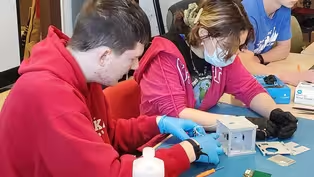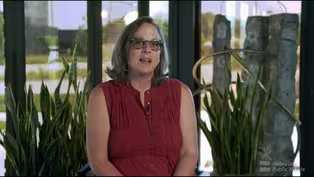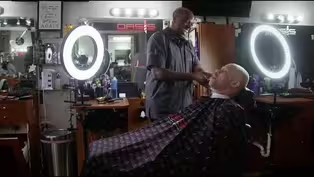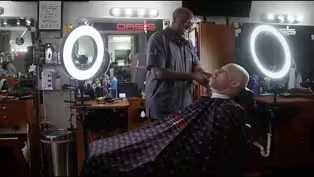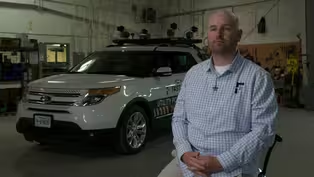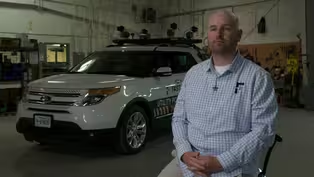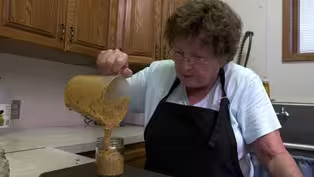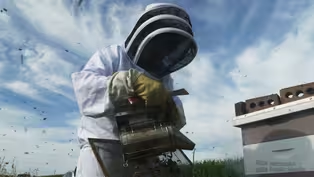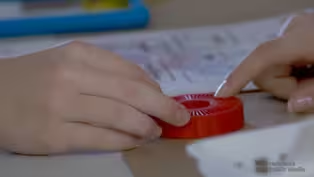
How students worked with NASA to build a small satellite
Preview: Season 6 | 6m 2sVideo has Closed Captions
NE junior high & high school students, built a small cube satellite that was launched into space.
Nebraska junior high and high school students, working with NASA and UNL faculty and students, built a small cube satellite that was launched into space to test solar panel materials. A story from the Nebraska Public Media series on innovation, creativity and entrepreneurship in Nebraska, "What If..." More at NebraskaPublicMedia.org/WhatIf and #WhatIfNebraska
Problems playing video? | Closed Captioning Feedback
Problems playing video? | Closed Captioning Feedback
What If is a local public television program presented by Nebraska Public Media

How students worked with NASA to build a small satellite
Preview: Season 6 | 6m 2sVideo has Closed Captions
Nebraska junior high and high school students, working with NASA and UNL faculty and students, built a small cube satellite that was launched into space to test solar panel materials. A story from the Nebraska Public Media series on innovation, creativity and entrepreneurship in Nebraska, "What If..." More at NebraskaPublicMedia.org/WhatIf and #WhatIfNebraska
Problems playing video? | Closed Captioning Feedback
How to Watch What If
What If is available to stream on pbs.org and the free PBS App, available on iPhone, Apple TV, Android TV, Android smartphones, Amazon Fire TV, Amazon Fire Tablet, Roku, Samsung Smart TV, and Vizio.
Providing Support for PBS.org
Learn Moreabout PBS online sponsorshipWe need somebody to hold the balloon hose in the helium.
Preston, you wanna do that?
Okay, cool.
[Mike] It's high altitude balloon launch day for the Big Red Satellite team.
Let it go and just kinda have your hands ready in that flat spoon position.
[Mike] The goal?
Test scientific equipment, the payload, they'll eventually send to space in a small satellite.
Tell me what you guys are doing.
We're connecting the sun sensor that we have on the payload to the actual like kind of computer, the brain of the payload.
I'm working on checking off the checklist, making sure everything gets done that's meant to get done before you launch.
(air hissing) I had to put on some latex gloves and help hold the balloon down when it blows up, just to make sure the wind doesn't shift it.
(dramatic music) And your payload's going up in a styrofoam beach cooler?
Mm hm.
It gets the job done.
[Team Member] Three, two, one, go.
(dramatic music continues) (team clapping and cheering) [Mike] The Big Red Satellite Project began in 2020, with Eastern Nebraska middle and high school students selected to work with NASA, University of Nebraska-Lincoln engineering students and faculty, and industry mentors and advisors.
They met Saturday mornings for several years, mostly in UNL's Aerospace Club lab.
Working on different aspects of the CubeSat that will test perovskites in space.
Hold on, let's take a second to explain these two things.
So what is a CubeSat?
So a CubeSat, it's a mini satellite.
And so it's a cube that's about 10 centimeters square.
And it has no propulsion system, so it gets launched into space.
And then it orbits.
And the orbit decays, and it burns up, and it comes back.
But it's small, but it can carry very interesting experimental payloads.
This is the top face of our payload fixture.
[Mike] Groups in lots of states have created CubeSats.
This is Nebraska's first.
A cost efficient way to do research in space on things like perovskites.
These are minerals that could be used in solar panels to more efficiently power space vehicles.
They are much thinner, lighter weight than traditional solar cells.
The unique thing about perovskites is that they may be able to collect reflected light and use that as energy.
And so that would provide a really useful alternative to current solar panels.
(air whooshing) [Mike] Each Saturday presents new tasks.
Oh, there's a big leak right here.
-Where?
-Why don't you mark it.
[Mike] Like building a chamber to work on the materials in something simulating space conditions.
Wait, what's the pressure at now?
[Team Member] Almost 101.
You said we would send one curve every three days.
[Mike] Budgeting for data coming back to earth from the CubeSat.
[Team Member] We're trying to see how much data we can send over.
[Mike] Which means what?
How we can test our perovskites in space with how much money it costs to send data back to us.
[Mike] Assembling a model of the CubeSat.
But this will actually carry our payload that does the research.
There's all sorts of different steps along the way that really add excitement.
Don't want to mess it up.
(laughs) (camera clicking) [Mike] A few months before the launch, it's photos and reflections, before the CubeSat leaves Lincoln.
[Photographer] Smile.
You look at all of this and like this is science, this is development engineering.
And we've gone through it, and we're finally here.
Now we're going to space.
I started this in high school.
And now that I'm in college it's like, wow, I'm still here.
(laughs) It's cool to see all the iterations that we've gone through.
And being a part of the team, getting to meet like all of these new people over the years.
It's just been a really fun experience.
My grandfather started, John McClure, started this whole thing.
And I feel like he would be really proud of where we are all right now.
He wanted to do something to bring aerospace industry to Nebraska to expose middle school and high school students to these opportunities.
[Countdown] Five, four... [Mike] The Lincoln entrepreneur passed away before getting to see this.
[Countdown] And liftoff at Jackson Center at eight five plus 40.
(inspiring music) [Second Countdown] T minus 60 seconds until deployment of Big Red Sat One from the International Space Station.
Five, four, three, two, one.
Mark.
-There it is.
-There we go.
-Look at us.
-Bye-Bye.
It's pretty cool to see though, isn't it?
Yeah, I mean there it goes.
I mean, it was just here, not that long ago.
This data may be of interest, you know, across the world.
There are lots of people studying perovskites.
So we'll be doing our data analysis, but there may be others who are actually analyzing our data as well.
[Mike] More than three years of hard work paid off.
The CubeSat gathered good information about new solar panel materials.
And a bunch of students, some starting this before they started high school, got the experience of a lifetime.
[Team Member] Go!
(team cheering) This process has been very helpful in realizing how much work goes into making a satellite, even when ours is this big.
So all that planning, building, and money that's gone into it, it's just a lot more than I expected.
I'm going to watch this thing get loaded onto a NASA rocket.
Like dumped out of a bag, and then shot off into space, where it's going to orbit around the earth.
And I'm going to have to look at data points for that is like so wild.
What do you hope the sort of legacy of this project is?
The experiences that the students are getting from this project is amazing, and it's inspiring them.
[Announcer] Ignition and liftoff.
How Tessa Porter combined her love of science and candy into a business
Video has Audio Description, Closed Captions
Clip: S6 | 9m 57s | How Tessa Porter combined her love of science and candy into a business, Sprinkk,. (9m 57s)
How students worked with NASA to build a small satellite
Video has Closed Captions
Preview: S6 | 6m 2s | NE junior high & high school students, built a small cube satellite that was launched into space. (6m 2s)
New "What If..." episodes are coming soon. Here's a preview!
Video has Closed Captions
Preview: S6 | 4m 19s | Preview of the four new season 6 "What If..." episodes (4m 19s)
How young entrepreneurs turned tragedy into triumph and created a "hotel" for horses & their owners
Video has Closed Captions
Preview: S6 | 9m 8s | Young entrepreneurs create horse hotel after tornado (9m 8s)
Video has Closed Captions
Clip: S6 | 3m 52s | The “What If…” team did something unusual; we told a story with one continuous shot! (3m 52s)
Wendy Goldberg's Advice for Young Entrepreneurs SR Version
Video has Audio Description, Closed Captions
Clip: S6 | 3m 2s | This segment features Wendy Goldberg, co-founder of the Tri Faith Initiative, Omaha, NE. (3m 2s)
Wendy Goldberg's Advice for Young Entrepreneurs JR Version
Video has Audio Description, Closed Captions
Clip: S6 | 3m 10s | This segment features Wendy Goldberg, co-founder of the Tri Faith Initiative , Omaha, NE. (3m 10s)
Lawrence Chatters & KB Mensah Share Advice for Young Entrepreneurs SR Version
Video has Closed Captions
Clip: S6 | 4m 48s | This segment features KB Mensah and Lawrence Chatters, co-founders of Visionary Youth, (4m 48s)
Lawrence Chatters & KB Mensah Share Advice for Young Entrepreneurs JR Version
Video has Closed Captions
Clip: S6 | 3m 10s | This segment features KB Mensah and Lawrence Chatters, co-founders of Visionary Youth, Lincoln, NE. (3m 10s)
D-Wayne Taylor's Advice for Young Entrepreneurs SR Version
Video has Closed Captions
Clip: S6 | 4m 18s | This segment features D-Wayne Taylor, vocal entrepreneur, Lincoln, NE. I (4m 18s)
D-Wayne Taylor’s advice for young entrepreneurs JR Version
Video has Closed Captions
Clip: S6 | 2m 9s | This segment features D-Wayne Taylor, vocal entrepreneur, Lincoln, NE. (2m 9s)
Dusty Birge's Advice For Young Entrepreneurs SR Version
Video has Closed Captions
Preview: S6 | 3m 26s | This segment features Dusty Birge, entrepreneur and Fast Forward CEO, Kearney, NE. #WhatIfNebraska (3m 26s)
Dusty Birge's Advice for Young Entrepreneurs JR Version
Video has Closed Captions
Clip: S6 | 2m 20s | This segment features Dusty Birge, entrepreneur and Fast Forward CEO, Kearney, NE #WhatIfNebraska (2m 20s)
Betty Sayers Advice for Young Entrepreneurs SR Version
Video has Closed Captions
Preview: S6 | 3m 24s | This segment features Betty Sayers, entrepreneur and Buzz Savories president, Holdrege, NE. (3m 24s)
How Entrepreneurship Save Sidney After the Major Employer Left Town
Video has Audio Description, Closed Captions
Clip: S6 | 13m 22s | Learn how a spirit of entrepreneurship saved Sidney after the Cabela's headquarters left town. (13m 22s)
Watch “Wiz” and Team Create Fun in the Sky!
Video has Closed Captions
Clip: S6 | 14m 20s | Learn how a Nebraska business creates drone shows throughout the U.S (14m 20s)
Betty's Bees and Her Mustard Business
Video has Closed Captions
Clip: S6 | 7m 2s | Follow Betty Sayers on her entreoreneurial journey to beekeeper and mustard maker in Holdrege, NE. (7m 2s)
See what kids (and the “What If...” team) create with a mystery widget!
Video has Closed Captions
Clip: S6 Ep1 | 10m 6s | See what kids create with a mystery widget, taking part in the 4-H INVENTUDay program. (10m 6s)
Providing Support for PBS.org
Learn Moreabout PBS online sponsorshipSupport for PBS provided by:
What If is a local public television program presented by Nebraska Public Media

